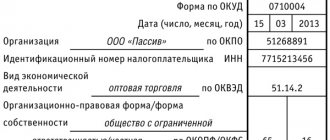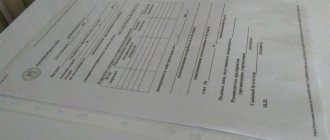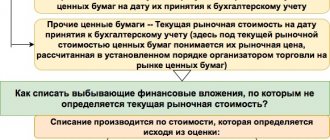Goals and objectives of cash accounting
Considering that the money of economic entities, both in cash and non-cash form, is one of the most highly liquid assets, cash accounting must fully provide data on the sources of their receipt and the direction of further use. Operations with financial resources involve performing tasks such as:
- documenting records of the organization's finances;
- compliance with legislation when making payments of various types;
- targeted use of funds;
- settlements with counterparties, budget, employees and other creditors.
The theoretical foundations of accounting for funds and their movement are reflected in PBU 23/2011. As part of the financial statements, to analyze financial information, enterprises use Form 4 “Cash Flow Statement”. The peculiarities of cash accounting also lie in the fact that economic entities that simultaneously apply several taxation regimes are required to maintain separate control over cash and non-cash receipts and expenses.
The tasks of cash accounting also consist of analyzing information about ongoing transactions for tax purposes. Thus, the cash expense register gives an idea of the actual expenses of the entity in the current period.
Accounting for an organization's funds
Accounting for an organization's funds involves monitoring their actual receipt and use. Representing highly liquid assets, cash includes:
- funds in bank accounts;
- cash on hand;
- reported funds;
- other assets with a high degree of liquidity.
Conducting settlements, especially accounting and control of funds in cash, is assigned, as a rule, to the financially responsible person.
Non-cash movements must be confirmed by relevant records. If an organization or individual entrepreneur uses cash payments in the course of its activities, then such transactions must strictly comply with all the rules of cash discipline. At the same time, it is allowed for small businesses and individual entrepreneurs to keep cash records in a simplified form.
Cash accounting at an enterprise is formed using accounts:
- 50 "Cashier";
- 51 “Current accounts”;
- 52 “Currency accounts”;
- 55 “Special bank accounts”;
- 57 “Translations on the way.”
GLAVBUKH-INFO
The presence and movement of funds in rubles and foreign currencies” located in letters of credit, check books, other payment documents (except bills), in current, special and other special accounts are recorded on account 55 “Special accounts in banks”. Account 55 “Special accounts in banks” also takes into account the movement of targeted financing funds in the part that is subject to separate storage. Depending on the type of funds accounted for, subaccounts can be opened for account 55 “Special accounts in banks”: 55–1 “Letters of credit”; 55–2 “Checkbooks”; 55–3 “Deposit accounts”; 55–4 “Special accounts in foreign currency”, etc. Sub-account 55–1 “Letters of credit” takes into account the movement of funds in letters of credit. Settlements under letters of credit are non-cash payments, and their procedure is regulated by the Regulations of the Central Bank of the Russian Federation on non-cash payments (for more details, see clause 2, section B of this chapter). The entry of funds into letters of credit is reflected in the debit of account 55 “Special accounts in banks” (subaccount 55–1 “Letters of credit”) and the credit of accounts 51 “Settlement accounts”, 52 “Currency accounts”, 66 “Settlements for short-term loans and borrowings” and other similar accounts. After using letters of credit, confirmed by bank statements, they are written off from account 55 “Special accounts in banks” (subaccount 55–1 “Letters of credit”) to the debit of account 60 “Settlements with suppliers and contractors”. Unused funds in letters of credit are restored by the bank to the account from which they were transferred. The recovery of funds is reflected in the credit of account 55 “Special accounts in banks” (subaccount 55–1 “Letters of credit”) in correspondence with account 51 “Settlement accounts” or 52 “Currency accounts”. The organization must maintain analytical accounting for subaccount 55–1 “Letters of credit” for each issued letter of credit. Subaccount 55–2 “Checkbooks” takes into account the movement of funds in checkbooks. Payments by checks are a non-cash form of payment, and their procedure is regulated by the Regulations of the Central Bank of the Russian Federation on non-cash payments (for more details, see clause 2, section B of this chapter). When checkbooks are issued to an organization, the organization’s funds are deposited, which is reflected in the debit of account 55 “Special accounts in banks” (subaccount 55–2 “Checkbooks”) and the credit of accounts 51 “Currency accounts”, 52 “Currency accounts”, 66 “Calculations for short-term loans and borrowings" and other similar accounts. Amounts from checkbooks received from the bank are written off as checks issued by the organization are paid, i.e., in the amount of redemption by the bank of checks presented to it (according to bank statements). The write-off of these amounts is reflected in the credit of account 55 “Special accounts in banks” (sub-account 55–2 “Check books”) and the debit of settlement accounts (76 “Settlements with various debtors and creditors”, etc.). Amounts for checks issued but not paid by the bank (not presented for payment) remain in account 55 “Special accounts in banks” (subaccount 55–2 “Check books”). The balance in subaccount 55–2 “Checkbooks” must correspond to the balance in the bank statement. Amounts for unused checks returned to the bank are reflected in the credit of account 55 “Special accounts in banks” (subaccount 55–2 “Check books”) in correspondence with account 51 “Currency accounts” or 52 “Currency accounts”. Analytical accounting for subaccount 55–2 “Checkbooks” is maintained for each checkbook received. Subaccount 55–3 “Deposit accounts” takes into account the movement of funds invested by the organization in bank and other deposits. The transfer of funds to deposits is reflected by the organization by debiting account 55 “Special accounts in banks” (subaccount 55–3 “Deposit accounts”) in correspondence with account 51 “Currency accounts” or 52 “Currency accounts”. When the bank returns deposit amounts, reverse entries are made in the organization's accounting records. The organization must maintain analytical accounting for subaccount 55–3 “Deposit accounts” for each deposit. Subaccount 55–4 “Special accounts in foreign currency” can take into account the movement of funds in accounts “P1” and “P2”, in particular, calculations and transfers when providing a loan to a non-resident in foreign currency and receiving a loan from a non-resident in foreign currency; for the acquisition from a non-resident and the alienation in favor of a non-resident of external securities, including calculations and transfers related to the transfer of external securities (rights certified by external securities), etc. On separate sub-accounts opened for account 55 “Special accounts in banks”, the movement of target financing funds separately stored in the bank is taken into account. In particular, they should take into account budget funds received by the organization to finance capital investments, accumulated and spent by the organization from a separate account, etc. Branches, representative offices and other structural divisions of the organization, allocated to a separate balance sheet, which open current accounts in credit organizations for the implementation of current expenses (labor expenses, individual business expenses, travel expenses, etc.), reflect the movement of these funds in a separate sub-account to account 55 “Special accounts in banks”. In accounting, transactions on current accounts are reflected similarly to transactions recorded on current accounts. The presence and movement of funds in foreign currencies are accounted for separately on account 55 “Special accounts in banks”. The organization must build analytical accounting for this account in such a way as to ensure the possibility of obtaining data on the availability and flow of funds in letters of credit, check books, deposits, etc. on the territory of the Russian Federation and abroad.| Next > |
Accounting for cash and non-cash funds
Cash circulation is strictly regulated. Accounting for cash is subject to the Procedure for conducting cash transactions approved by the Bank of Russia Directive No. 3210-U dated March 11, 2014. Any incoming or outgoing transactions must be reflected using unified documents, including a cash book, cash orders, must be approved in continue to comply with the cash balance limit. A financially responsible person is appointed to be responsible for performing cash transactions.
Accounting for cash flows in an LLC in cash can be located in subaccounts:
- 50.1 - all funds in domestic currency are taken into account. The presence of foreign cash requires the opening of additional sub-accounts;
- 50.2 - operational cash desks, used at additional money collection points, for example, at retail outlets;
- 50.3 - opens if other monetary documents are stored at the organization's cash desk - tickets, stamps, etc.
Example 1.
The cash balance limit of the organization is set at 45,000 rubles. At the beginning of the working day there were 35,000 rubles in the cash register. The following operations were performed: receipt of payment from customers - 18,000 rubles, withdrawal from the bank for employee salaries - 118,000 rubles, issuance of salaries - 118,000 rubles, issuance of a report - 25,000 rubles. The cash accounting table (receipt, expense, balance) will look like this:
Opening balance Account Dt Kt account Amount, rub. the name of the operation Closing balance 35 000 50 62 18 000 Payment from buyers 53 000 53 000 50 51 118 000 Receipt from current account 171 000 171 000 70 50 118 000 Payment of wages to employees 53 000 53 000 71 50 25 000 Issuance of funds accountable 28 000
Accounting for funds by bank transfer is carried out using account 51 - open bank accounts. Receipts form a debit of the account, write-offs form a credit. Example entries:
- Dt 51 - Kt 62 - payment from counterparties has been credited;
- Dt 68 - Kt 51 - payment of taxes;
- Dt 60 - Kt 51 - payment to suppliers;
- Dt 91 - Kt 51 - commission for banking services has been written off.
Most incoming expenditure transactions must be carried out in non-cash form, since the law limits payment in cash. Between legal entities, such settlements should not exceed 100,000 rubles per agreement.
It is allowed to open several bank accounts. To store money in the currencies of other countries, account 52 is used. Accounting for the movement of funds in this account is subject to currency regulation, that is, balances in foreign currency are converted into rubles upon completion of any transactions. As a result, exchange rate differences are formed - positive or negative, depending on the ruble exchange rate on the date of the operation.
The lecture covers the following issues:
1. Accounting for cash and monetary documents at the cash desk
2. Accounting for transactions on current accounts
3. Accounting for transactions on special accounts
4. Accounting for transfers en route
Literature:
1.Babaev Yu.A., Petrov A.M., Melnikova L.A. Accounting. Textbook for bachelors. – M.: Prospekt, 2014.
2. Federal Law of December 6, 2011 No. 402-FZ “On Accounting”
3. Federal Law of May 22, 2003 No. 54-FZ “On the use of cash register equipment when making cash payments and (or) payments using payment cards”;
4. Letter of the Central Bank of the Russian Federation dated October 12, 2011 No. 373-P “Procedure for conducting cash transactions with banknotes and coins of the Bank of Russia on the territory of the Russian Federation”;
5. Instruction of the Central Bank of the Russian Federation dated June 20, 2007 No. 1843-U “On the maximum amount of cash payments and the expenditure of cash received at the cash desk of a legal entity or the cash desk of an individual entrepreneur.”
Funds are located at the cash desk in the form of cash and monetary documents, in bank accounts, issued letters of credit, check books, in special and deposit accounts, etc. With the help of funds, settlements are made with suppliers for inventory items purchased from them, with buyers - for the goods they purchased, products with customers - for work performed and services provided, with credit institutions - for loans and other financial transactions, with the budget - for taxes and fees, with other legal entities and individuals - for various business transactions.
Cash payments are made either in the form of non-cash payments or in cash.
To account for funds, the accounting accounts located in section V “Cash” of the Chart of Accounts for accounting financial and economic activities of organizations are used (50 “Cash”, 51 “Settlement accounts”, 52 “Currency accounts”, 55 “Special accounts in banks ", 57 "Translations on the way").
1. Accounting for cash and monetary documents at the cash desk
Cash transactions include any movement, i.e., change in cash balances in domestic and foreign currencies, monetary documents stored in the organization's cash desk. Organizations, regardless of organizational and legal forms and scope of activity, are required to store available funds in banking institutions. Organizations make payments for their obligations with other organizations, as a rule, non-cash through banks or use other forms of non-cash payments established by the Central Bank of the Russian Federation in accordance with the legislation of the Russian Federation.
To make cash payments, each organization must have a cash register and maintain a cash book in the prescribed form. The acceptance of cash by organizations when making payments to the population is carried out with the mandatory use of cash registers.
Cash received by organizations from banks is spent for the purposes specified in the check.
Conducting cash transactions is entrusted to the cashier, with whom, in accordance with labor legislation, an agreement is concluded on full financial responsibility for the safety of all valuables accepted by him and for damage caused to the enterprise both as a result of intentional actions and as a result of a negligent or dishonest attitude towards his duties. In organizations with several cash registers (for example, trade, transport, etc.), there is a main cash register, which is maintained by the chief cashier, to whom the cashiers of the operating cash desks report and report daily.
The heads of organizations are obliged to equip a cash desk (an isolated room intended for receiving, issuing and temporary storage of cash) and ensure the safety of money in the cash desk premises, as well as when delivering it from a bank institution and depositing it at the bank. The cash register premises must be isolated, and the doors to the cash register must be closed from the inside during transactions. Access to the cash desk premises by persons not related to its work is prohibited.
In accordance with the instruction of the Central Bank of the Russian Federation dated June 20, 2007 No. 1843-U “On the maximum amount of cash payments and the expenditure of cash received at the cash desk of a legal entity or the cash office of an individual Entrepreneur,” a maximum amount of cash payments is currently established in the Russian Federation between legal entities (individual entrepreneurs) for one transaction in the amount of 100 thousand rubles.
The joint letter of the Central Bank of the Russian Federation dated July 2, 2002 No. 85-T and the Ministry of Taxes of Russia dated July 1, 2002 No. 24-2-02/252 “On issues of settlements between legal entities in cash” clarified that the maximum amount of settlements in cash refers to settlements within the framework of one agreement concluded between legal entities. Cash settlements carried out between legal entities under one or more documents under one agreement cannot exceed the maximum amount of cash settlements.
However, these restrictions do not apply to settlements involving individual entrepreneurs.
Cash desks of enterprises can store cash within the limits established by the banking institutions that serve them in agreement with the heads of these enterprises. The cash limit is the maximum amount of money that can be permanently kept in the organization's cash register.
The cash balance limit in the cash register is established for all enterprises, regardless of their legal form and field of activity, that have a cash register and carry out cash payments independently.
To establish a cash balance limit in the cash register, the company draws up a “Calculation for establishing a cash balance limit.”
The cash balance limit is determined based on the volume of cash turnover of an enterprise, taking into account the peculiarities of its mode of operation, the procedure and timing of depositing cash at bank institutions, ensuring safety and reducing counter transportation of valuables.
The cash balance limit may be revised during the year in accordance with the established procedure (in case of changes in the volume of cash turnover, conditions for the delivery of proceeds, etc.).
All cash in excess of the established cash balance limit at the organization's cash desk must be deposited with the bank within the agreed time frame. Cash can also be handed over to collectors and to joint cash desks at enterprises for subsequent delivery to the bank, as well as to communication companies for transfer to bank accounts on the basis of concluded agreements.
Enterprises with constant cash revenue can spend it on wages and social and labor benefits, purchasing agricultural products, purchasing containers and things from the population.
To record cash transactions, unified forms of primary documentation are used, approved by Resolution of the State Statistics Committee of Russia dated August 18, 1998 No. 88 (as amended on May 3, 2000), agreed upon with the Ministry of Finance of Russia and the Ministry of Economy of Russia (Fig. 7.1).
Rice. 7.1. Primary documents for recording cash transactions
A special feature of cash documents is that they cannot be erased, blotted out or corrected. If errors were made when drawing up a document, the unregistered and pre-numbered document is destroyed and the correct one is written out in its place. In other cases, an incorrect document is canceled by crossing it out and the inscription “cancelled”; a new document is issued under the next serial number. Cash documents must be filled out clearly and clearly in ink, ballpoint pen or written out using a typewriter, computer equipment and must be signed by the chief accountant or other person authorized by written order of the head of the enterprise, and the cashier, and expense documents, in addition, by the head of the enterprise or other official authorized to authorize the expenditure of funds. Incoming and outgoing orders indicate the basis for their preparation and list the documents attached to them.
About the receipt of money, a receipt is issued for the cash receipt order, signed by the chief accountant or a person authorized to do so, and the cashier, certified by the seal (stamp) of the cashier or the imprint of the cash register.
Cash issuance from the cash registers of enterprises is carried out according to cash outflow orders or properly executed other documents (pay slips (settlement and payment), applications for the issuance of money, accounts, etc.) with a stamp placed on these documents with the details of the outgoing cash order. In cases where the documents, statements, invoices, etc., attached to the cash vouchers have the permission of the head of the enterprise, his signature on the cash vouchers is not required.
Acceptance and issuance of money under cash orders can only be carried out on the day they are drawn up. Receipt and expense cash orders or documents replacing them are immediately signed by the cashier after receiving or issuing money on them, and the documents attached to them are canceled with a stamp or the inscription “Paid” indicating the date (day, month, year).
Incoming and outgoing cash orders or documents replacing them are registered by the accounting department in the register of incoming and outgoing cash documents before being transferred to the cash desk. Registration of incoming and outgoing cash documents can be carried out using computer technology.
Analytical accounting of cash transactions is maintained by the cashier in the cash book. Each enterprise maintains only one cash book, which must be numbered, laced and sealed with a wax or mastic seal. The number of sheets in the cash book is certified by the signatures of the manager and chief accountant. If the organization has operating cash desks, then the cash flow in the operating cash desks is reflected in the books of cashiers-operators. Then the cash book is maintained by the chief cashier.
Entries in the cash book are made in duplicate using carbon paper in ink or a ballpoint pen. The second copies of the sheets should be tear-off, as they serve as a cashier’s report. The first copies of sheets remain in the cash book. The first and second copies of sheets are numbered with the same numbers. Erasures and unspecified corrections in the cash book are not permitted. The corrections made are certified by the signatures of the cashier, as well as the chief accountant of the enterprise or the person replacing him.
All cash receipts and disbursements of the enterprise are recorded in the cash book.
Entries in the cash book are made by the cashier immediately after receiving or issuing money for each order or other document replacing it. Every day at the end of the working day, the cashier calculates the results of transactions for the day, displays the balance of money in the cash register on the next date and transfers to the first accounting department as a cashier’s report a second tear-off sheet (a copy of the entries in the cash book for the day) with receipts and expenses cash documents against receipt in cash book.
At enterprises, provided that the complete safety of cash documents is ensured, the cash book can be maintained in an automated way.
Control over the correct maintenance of the cash book rests with the chief accountant of the enterprise.
The basis for recording cash transactions on accounting accounts is the cashier's report with primary documents attached to it. The cashier submits the report to the accounting department against the receipt of the accountant receiving it. The latter checks the correctness of the recording of primary documents in the report and its results. In organizations that conduct settlements using cash registers, a cash report is also compiled with the indicators of the cash register counters, which are printed at the end of cash register operation and attached to the cashier’s report. In this case, meter readings may exceed the amount of cash proceeds by the amount of sales paid by credit cards, which is reflected as transfers in transit, and cash documents.
Accounting for cash in the cash register is carried out on the basis of cash documents in account 50 “Cash”. The receipt of funds to the cash desk is shown as a debit of the account, and the expense - as a credit. Accounts corresponding to account 50 “Cash” are indicated by the accountant in the primary cash documents - orders and statements - at the time of their issuance, i.e. even before the cash transaction itself, and then they are transferred from the documents to the cash book.
Sub-accounts can be opened for account 50 “Cashier”:
50-1 “Organization cash desk”;
50-2 “Operating cash desk”;
50-3 “Cash documents”, etc.
Subaccount 50-1 records cash in the organization’s cash register, including for accounting for the availability and movement of Russian currency, as well as for each foreign currency used. The main source of their receipt at the cash desk is the withdrawal of cash by checks from the current account. When checking this transaction, you need to make sure that the check counterfoil, the receipt order and the cashier's report indicate an identical amount, and compare it with the bank account statement. The receipt of cash at the cash desk from the current account is reflected in the debit of account 50 “Cash” from the credit of account 51 “Settlement accounts”, 52 “Currency accounts” (if funds are withdrawn in foreign currency).
In organizations that conduct settlements with the population, the bulk of cash goes to the cash desk in the form of cash proceeds - a debit to account 50 “Cash” and a credit to the “Sales” account. Also, cash is deposited into the cash register by accountable persons, workers and employees, buyers and other counterparties.
Cash from the cash register is spent primarily on paying wages by debiting account 70 “Settlements with personnel for wages” and crediting account 50 “Cash”. Amounts not paid out according to the statement are deposited and debited to account 70 from the credit of account 76-4 “Calculations for deposited amounts” (Table 7.1).
Table 7.1
Accounting for cash transactions
| Contents of operations | Debit | Credit | Amount, rub. | Primary document |
| Reflects the debiting of funds from a bank account and their receipt at the organization's cash desk | 50-1 | 100 000 | Receipt cash order, bank account statement | |
| Salaries issued to employees of the organization | 50-1 | 96 000 | Payroll, cash order | |
| Reflected the deposit of the amount of unpaid wages | 76-4 | Payroll, accounting certificate | ||
| The deposited amount of cash was deposited into the bank account | 50-1 | Cash disbursement order, bank account statement |
Cash proceeds and cash balances in excess of the established limit are handed over to the bank. When the cashier of an organization deposits money directly into the bank’s cash desk, an entry is made: debit 51 “Currency accounts”, 52 “Currency accounts” and credit 50 “Cash”. If the proceeds are transferred to collectors or given to the post office for transfer to an account, then account 57 “Transfers in transit” is debited.
Subaccount 50-2 takes into account the availability and movement of funds to operating cash desks (cash desks opened in departments of the organization). The issuance of money from the main cash register to the operating rooms and its return is recorded in the book of accounting for funds accepted and issued by the cashier (form No. KO-5). When the chief cashier issues funds to the operating cash registers, a debit entry is made to subaccount 50-2 “Operational cash desk” from the credit of subaccount .10-1 “Organizational cash register”. When funds are deposited into the main cash register, a reverse entry is made.
Subaccount 50-3 takes into account monetary documents in the organization's cash desk. Monetary documents include postage and bill of exchange stamps, paid air tickets, state duty stamps, vouchers to holiday homes and sanatoriums and other monetary documents. Monetary documents are accepted for accounting and reflected in the balance sheet in the amount of the actual costs of their acquisition, and not at their nominal value.
Accounting for the receipt and disposal of monetary documents is carried out using incoming and outgoing cash orders. The cashier records the cash order data in the book of movement of cash documents, which is a register of analytical accounting of cash documents. Analytical accounting of monetary documents is carried out by their types. The book of accounting for the movement of monetary documents can be kept on forms and is similar to the cash book.
The receipt of monetary documents at the cash desk is reflected in the debit of account 50-3 “Cash Documents” from the credit of the following accounts:
— 50-1 “Cash desk of an organization” — when purchasing monetary documents in cash;
— 71 “Settlements with accountable persons” — when submitting documents purchased by employees of the organization to the cash desk;
- 76 “Settlements with various debtors and creditors” - upon receipt of monetary documents purchased by bank transfer.
The issuance of monetary documents for reporting is reflected in the credit of account 50-3 and the debit of the accounts:
- 71 “Settlements with accountable persons” - when issuing documents for reporting (for example, tickets for travel to a business trip);
- 76 “Settlements with various debtors and creditors” - when returning monetary documents purchased by bank transfer (for example, when returning tickets to a transport agency);
— 26 “General business expenses” — when using monetary documents for the needs of the organization (for example, sending postal correspondence);
— 73 “Settlements with personnel for other operations” — when issuing vouchers to employees. If vouchers are paid only partially by employees, then part of their cost paid by the organization is credited to account 50-3 to the debit of account 91-2 “Other expenses”.
Cash register inventory. The general procedure for conducting an inventory of an organization’s property is set out in Art. 11 of the Federal Law “On Accounting” and is detailed in the Methodological Guidelines for Inventories of Property and Liabilities, approved by Order of the Ministry of Finance of Russia dated June 13, 1995 No. 49.
The procedure and timing of the inventory are determined by the head of the organization, except for cases when the inventory is mandatory. Inventory is required to be carried out:
— before preparing annual financial statements;
- when changing financially responsible persons;
— when facts of theft, abuse or damage to property are revealed;
— in case of a natural disaster, fire or other emergency situations caused by extreme conditions;
— during reorganization or liquidation of the organization.
In accordance with clause 37 of the Procedure for conducting cash transactions, within the time limits established by the head of the enterprise, as well as when changing cashiers, each enterprise carries out a sudden audit of the cash register with a complete page-by-sheet recalculation of cash and checking of other valuables in the cash register. The cash balance in the cash register is verified with the accounting data in the cash book. To carry out an audit of the cash register, a commission is appointed by order of the head of the enterprise, which draws up an act. If the audit discovers a shortage or surplus of valuables in the cash register, the act indicates their amount and the circumstances of their occurrence.
The founders of enterprises, higher organizations (if any), as well as auditors (audit firms), in accordance with concluded agreements, when carrying out documentary audits and checks at enterprises, audit the cash register and check compliance with cash discipline. In this case, special attention should be paid to the issue of ensuring the safety of money and valuables.
Resolution of the State Statistics Committee of Russia dated August 18, 1998 No. 88 “On approval of unified forms of primary accounting documentation for recording cash transactions and accounting for inventory results” approved the following unified forms for accounting for inventory results:
— act of inventory of cash (form No. INV-15);
— inventory list of securities and forms of strict reporting documents (form No. INV-16).
Excess money identified by inventory comes to the cash desk and is credited to the organization’s income: debit to account 50 “Cash” and credit to account 91 “Other income and expenses.”
The shortage of funds in the cash register is subject to recovery from the financially responsible person (cashier). In this case, the following entries are made: debit account 94 “Shortages and losses from damage to valuables” and credit account 50 “Cash” for the missing amount of funds. And at the same time it is attributed to the culprit of the shortage: the debit of account 73 “Settlements with personnel for other operations” and the credit of account 94 “Shortages and losses from damage to valuables.”
If recovery from the guilty persons is refused by the court or they are not found (for example, in the case of robbery, burglary, etc.), the shortage is written off as expenses of the organization: debit account 91 “Other income and expenses” credit account 94 “ Shortages and losses from damage to valuables.”
Accounting for other funds
In addition to cash registers and current accounts, economic entities have the right to store funds using special bank accounts: letters of credit (one of the forms of non-cash payments in which the bank transfers funds by order of the client), deposits, check books. For these purposes, cash accounting is carried out using account 55.
Special bank accounts are used when it is necessary to carry out special transactions. For example, deposits are used to store money in credit institutions at increased interest rates, while check documents contain an order to issue funds to the bearer.
Another account that reflects information about the availability of money is account 57 “Cash in transit.” Used in cases where there are some temporary differences in movement, for example:
- Dt 57 - Kt 50 - money issued from the cash register to replenish a bank account;
- Dt 51 - Kt 57 - receipt to the bank account.
Cash accounting (briefly) is generalized information about the movement, receipt and use of monetary assets in an enterprise.
Correspondence on individual deposit forms
Let's consider the transactions used for specific deposits.
Letter of Credit
A letter of credit is a commitment made by a bank. That is, the bank issues funds to the company's counterparty on behalf of the latter. A letter of credit is used for settlements with one person. To open it, you need to fill out an application indicating this information:
- Details of payment documents.
- Form of letter of credit.
- Terms of payment.
- Account number to be credited.
- Validity.
- The name of the goods and services that are paid for using the letter of credit.
- Number and date of agreement with the counterparty.
- Product shipment time.
The letter of credit is closed under the following circumstances:
- The letter of credit has expired.
- A corresponding application has been received from the supplier or buyer.
- Incomplete use of the account.
A notice is sent to the buyer prior to closing. The use of account 55 (subaccount 1) is determined by the type of letter of credit and the conditions for its opening. An uncovered letter of credit is taken into account behind the balance on account 009. When written off, this posting is made: DT55, subaccount 1 KT51, 52, 66. The posting is made on the basis of a bank statement with the documents attached to it.
The amounts used are written off using this entry: DT60 KT55, subaccount 1.
After debiting, the bank performs final operations. In particular, if the letter of credit is not fully used, the balance is returned to the account. In this case, you need to make this entry: DT51, 52 KT55, subaccount 1.
Analytical account accounting is performed for each letter of credit. This allows you to accurately track the movement of funds.
Checks
The movement of funds on checks is carried out on account 55 (subaccount 2). A check represents a security. It involves the order of the owner of the check to pay funds to the holder of the check. The check holder is the person to whom the document was issued. The issuance of a check is recorded using this posting: DT55, subaccount 2 KT51, 52, 66.
Securities presented for payment when purchasing material assets are reflected in this entry: DT60, 76 KT55, subaccount 2.
Unused amounts that were returned to the bank are recorded by this posting: DT51, 52 KT55 (subaccount 2).
Funds from checks that are not cashed remain in the 55/2 account. The amount must be equal to the balance on your bank statement.
Deposit
The movement of funds on bank deposits is carried out on account 55 (sub-account 3). These entries are made:
- DT55/3 KT91/1. Accrued interest on the deposit.
- DT51, 52 KT55/3. Return of deposit.
Analytical accounting is carried out for each of the deposits.
Targeted financing, funds from branches, etc.
Targeted financing is recorded on account 55. Separate sub-accounts are opened for it. A separate sub-account is also needed to record the movement of funds from branches and structural divisions. It is also required to reflect funds transferred from the account for the purchase of bank cards. The purchase of a card is recorded using this entry: DT55 (sub-account “Card Account”) KT51.
The posting is carried out on the basis of an account statement as of the date the money is written off. Card payments are confirmed by bank statements. The issuance of a card to an employee is reflected by this posting: DT71 KT55, subaccount “Card Account”.
Entries are made on the basis of statements and documents on the basis of which the card was issued. The employee is required to confirm the legality of the expenditure of funds. To do this, you need these documents: receipts, sales receipts, invoices, invoices. Typically, the employee prepares expense reports for the card. You need to attach a primary to them. The employee's expenses are recorded using this posting: DT10, 20, 26, 41 KT71.
Analytical accounting is carried out for issuing banks, cards and users of these cards. Information on account 55 is summarized using a PC. The statement must record the balance of debit and credit turnover.
Transfers on the way
Transfers in transit are funds that have been deposited into a bank or post office, but have not yet been credited to the account. They are reflected in account 57. Primary accounts are credit receipts, receipts from a savings bank or post office, statements for the delivery of proceeds to collectors. The transfer of amounts is reflected by this posting: DT57 KT50.
The transfer of money to the account is recorded by this entry: DT51 KT57.
The movement of foreign currency must be recorded separately from other funds. Analytical and synthetic accounting, if the journal-order form of accounting is adopted, is carried out in journal-order No. 3. The primary document is a bank statement.











